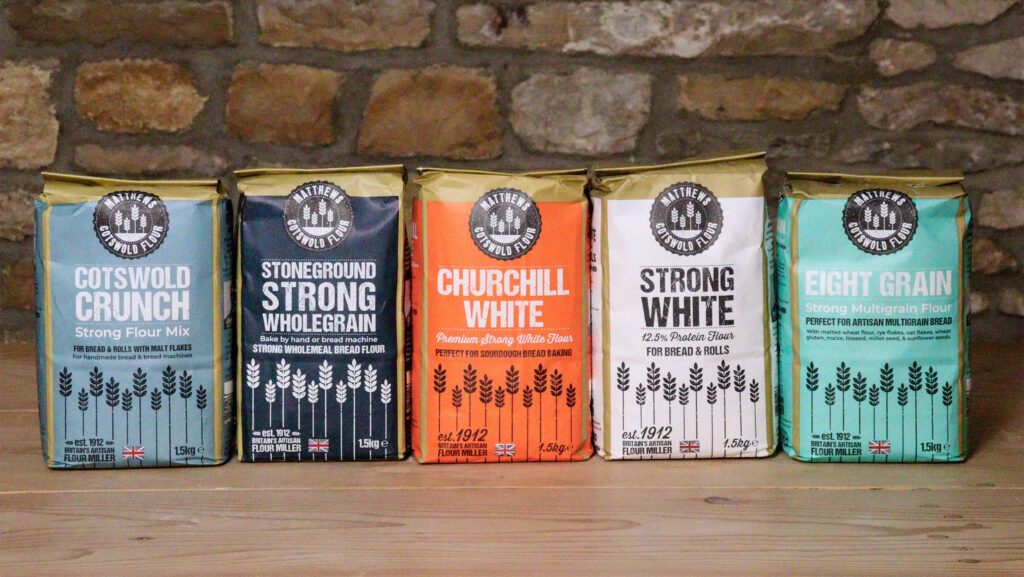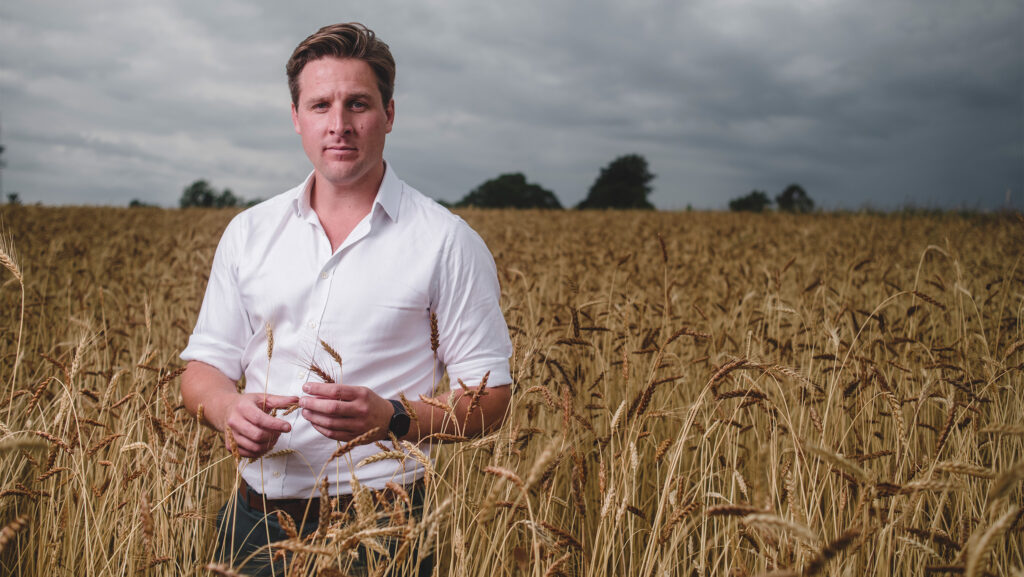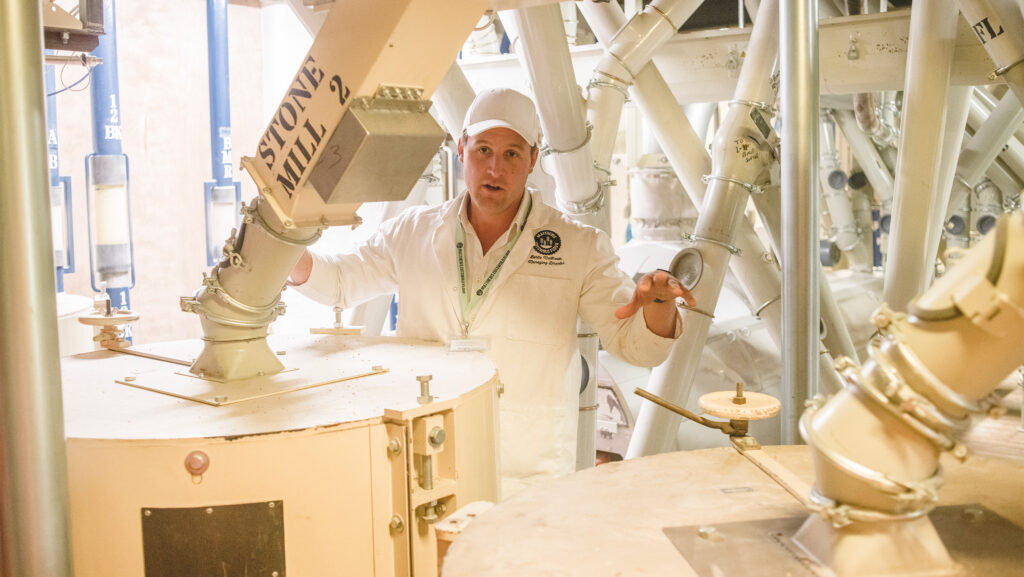Cotswold flour mill sources grain direct with stacked premiums
 © Matthews Cotswold Flour
© Matthews Cotswold Flour
An eighth-generation flour mill business is sourcing grain direct from over 150 farms to produce one of the UK’s top artisan flour brands, while enabling growers to stack regenerative farming and milling premiums.
Since its establishment in 1912, Matthews Cotswold Flour has expanded to produce more than 100 types of flour, ranging from strong protein to ancient grains.
The brand’s selection has become a “one-stop shop” for many bakeries across the UK, providing its farmer suppliers with a host of opportunities.
See also: 7 steps for late drilling wheat success

Bertie Matthews © Matthews Cotswold Flour
Whether it is a standard milling variety, organic production or the latest regenerative crops, working directly with farmers is a top priority for the Cotswold mill.
Miller Bertie Matthews, managing director of the firm, now sets his sights on having 100% of his flour regeneratively grown by 2030.
Mill history
The mill has evolved from a family farm to producing 30,000-35,000t of flour each year, including overcoming a turbulent year of financial difficulty.
“The Matthews family initially moved from Warwickshire to the Cotswolds in 1802, buying a 500-acre (202ha) arable farm near Shipton-under-Wychwood.
“In 1860, the Great Western railway was built adjacent to the farm, so my great, great, great, great grandfather decided to build a mill on the farm so that he could sell and transport flour into the cities. Liverpool and London were the first he sold to.”
The mill was completed in 1912 and, fast forward to today, Matthews Cotswold Flour now sells to a number of supermarkets including Tesco, Waitrose and the Co-op. It is one of 18 flour companies in the UK.
“The UK currently produces 5m tonnes of flour each year, so we’re comparatively small in the market place. Our biggest market is selling to bakeries, followed by supermarkets, online and wholesale,” explains Bertie.

The mill at Matthews Cotswold Flour © Matthews Cotswold Flour
Business restructure
However, the mill was faced with huge financial uncertainty in 2017.
Costs were escalating, staffing was problematic and the business was at the mercy of volatile markets when sourcing grain from merchants.
Bertie decided it was time to give up his job in the city and return to the family business.
His focus was working directly with farmers to future-proof the milling enterprise, which has existed for over 100 years.
“We created a strategy to make direct contact with farmer suppliers – it has made the world of difference. We were able get a handle on costs and quality rather than buying flour from merchants, which left us exposed to the global market,” explains Bertie.
“I founded the Cotswold Grain Partnership, which is a network of farmers, millers, and bakers who share the same vision to collaborate and produce high-quality flour and bread.
“We now have more than 150 farmer suppliers, which continues to grow. We even have an in-house baker to help develop product ideas,” he says.
Regenerative principles
Passionate about promoting regenerative practices that enhances soil health and biodiversity, Bertie launched the UK’s first fully regenerative all-purpose white flour.
The flour is now the number-one bestseller among bakers, as it can be used for biscuits, buns, cakes and breads.
“Farmers want to reduce their inputs and save costs. Bakers want high-quality, multi-use flour at an affordable price.
“It’s all a balancing act. Working with the supply chain is vital to achieving this, which is why we launched the regen flour product” he says.
What started with a couple of regenerative farmers supplying grain has developed into a growing market, enabling growers to stack substantial premiums.
Farmers supplying the mill with grain now have the below options to choose from:
- Standard milling premium, such as a Group 2 or 4 variety
- A high-protein Group 1 milling wheat
- Specialised grain, such as spelt, einkorn, or emmer, which offers higher premiums
- Organic certification
- Regenerative farming system where growers follow a set of in-house standards.
The regenerative standards are based on five key parameters:
- Soil – increased soil fertility and organic matter
- Carbon – improvements to carbon sequestration
- Water – increased soil water infiltration
- Biodiversity – enhanced landscape biodiversity
- Food security – yield and financial sustainability for farmer and consumer.
Farmers must demonstrate these standards to a set of independent auditors and are permitted to use a maximum of 180kg N/ha. Pre-harvest glyphosate is not permitted.
A scalable regenerative premium is also on offer. “Farmers who have farmed regeneratively for five years or more are paid a higher premium than those who are starting out on their journey.”
Payment is also made according to how much nitrogen is applied and grain protein.
For example, a farmer who grows 12.5% grain protein from 140kg N/ha will be paid more than a farmer who grows 12.5% grain protein from 180kg N/ha.
“This is effectively double the benefit for farmers.” However, Bertie speculates that with time, regenerative premiums will change as regenerative practice becomes more mainstream.
“The early adopters can make the most of these premiums, but I foresee this being relatively short lived as regenerative farming becomes standard practice.”
“One thing is clear from our data records is that regeneratively grown wheat varieties tend to have a grain protein content a couple of percentage points lower than conventionally grown crops of the same variety, which may impact market requirements,” notes Bertie.
The milling process at Matthews Cotswold Flour
Managing director Bertie Matthews talks us through the milling process from field to flour.
“The process all begins when we reach out to farmers in September to select grain and agree contracts,” says Bertie.
Once the crops are harvested, a sample is collected before delivering to the mill. The grain is then cleaned, before conditioning with water.
This softens the outer brown layer of the grain and aids the milling process.
Gristing follows, which involves breaking the grains into smaller particles, before milling via a traditional stone mill or modern roller.
“Generally, the specialist varieties are stone milled and white plain flour is roller milled,” says Bertie.
“Stone milling creates a natural smell, flavour and texture profile, particularly when using specialist grains like spelt.
“Roller milling on the other hand suits white flour production for an even milling process,” he says.
The flour is then sifted. Generally, 78% of grain is turned into flour and the remaining 22% is used as livestock feed.
Flour is then stored ahead of packing, or blended if it is a multigrain product. “Cotswold Crunch, for example, is our bestseller in supermarkets and is a mix of wheat, rye and wholegrain.”
Flour is then bagged into 1kg, 1.5kg or 16kg bags. A 500g ready-to-go bread mix is also available.
It is then delivered all over the country from Cornwall to Aberdeen, but predominantly in a 40-mile radius.
Milling equipment has been heavily invested in recent years, upgrading production lines to promote both cost and carbon efficiency.
“We are now using 100% renewable energy and 100% recycled packaging, with targets on wastage and miles travelled,” he says.
Bertie also founded the Cotswold Flour Baking Club, a platform that provides baking resources, education, and events to inspire the new generation of bakers and celebrate the art and craft of baking.

Bertie Matthews in the mill © Matthews Cotswold Flour
Case study: Craig Livingstone, Lockerley Estate and Preston Farms, Hampshire
Craig Livingstone, director of farming and estates at Lockerley Estate and Preston Farms, has supplied grain to Matthews Cotswold Flour for the past four years and is stacking both regenerative and milling premiums.
Harvest 2024 saw him commit 700t of grain to the Cotswold mill, and he is currently undergoing contracts agreements for this year’s crop.
The estate team have used regenerative practices for nearly a decade, gearing themselves up for regenerative contracts and are now reaping the rewards.
“The system fits really well. We can’t and won’t grow full-spec milling wheats with 170kg/ha N and hit 13-14% grain protein in wheats, but we can grow Group 2 and 3 varieties in a regenerative way to hit premiums,” says Craig.
This season, 36% of this year’s wheat destined for the mill is a Group 2 blend of Mayflower, Palladian and Extase, which usually achieves 11% protein.
Malika spring wheat is another favourite on heavy clay cap as a spring crop alternative to barley. Although lower yielding (5t/ha), it achieved between 13-14% grain protein content, which paid £265/t.
What Craig finds particularly fulfilling, is the opportunity he now has to be part of a connected and aligned supply chain.
“The estate recently hosted Hobbs House bakery, which Matthews Cotswold Flour supplies to with Lockerley flour,” he says.
“It was great to have farmer, miller and baker all working together. Now we just need to bring the consumer into this.
“We’ve worked hard to develop efficiency and productivity into our business, but now we need our customers to value the complexity associated with regen crop production at scale.”
Craig’s major concern is whether bakers will alter their 13% or more grain protein stipulation, particularly as regeneratively grown crops tend to have lower protein levels, due to efforts in reducing artificial inputs.
“The supply chain and consumers are demanding us to reduce nitrogen use in crops, but in some cases this may not be possible. We need to address these issues throughout the supply chain.
“There must be compromise on all sides – if we are to get real about meeting net zero, carbon, biodiversity targets, then we must see innovation and realistic expectations on grain protein requirements.
“There is a host of other products, such as pittas and flatbreads, which can be made with lower grain protein levels,” he says.
“We want to be in market of growing regenerative food, not feed.”
Case study: Annie Landless, Ampney Brook Farm, Gloucestershire
Ampney Brook Farm in the Cotswolds is a mixed beef and arable farm, supplying three local mills with organically produced heritage and population grains.
The farm’s enterprise development manager, Annie Landless, is set to sell 8ha of emmer and einkorn heritage grain to Matthews Cotswold Flour this season, which she hopes will hit the £1,000/t mark.
“Growing heritage and population grains fits well with our min-till organic system and is relatively niche, so it makes sense to sell our 25ha arable area to three local mills,” says Annie.
However, she notes yields are considerably lower than conventional varieties, so achieving the organic milling premiums is crucial to making a return.
“For harvest 2024, we grew heritage/ancient grains emmer and einkorn for Matthews, a heritage population wheat for Shipton Mill and population wheats for Cann Mills.”
This season, Annie is not growing winter crops. Instead, she is putting her arable acreage into spring cropping as the land is currently too wet to get crops in the ground.
After discussions with Bertie Matthews, managing director of Matthews Flour, the pair agreed that spring spelt would be a great option for the farm to grow.
“The relationship with Matthews Flour is really nice. We are only 20 miles from the mill and it’s great to know where our produce is going.
“It’s nice to be able to build up a direct contact with the mill and have Bertie come out on farm to discuss things. What’s more, it’s great to see the mill share our story with the wider public.”
As Annie scales up the arable area at the 220ha farm, she is keen to continue to work closely with the mill as part of a more transparent supply chain.
The farm also has a herd of 100% grass fed Hereford beef cattle which is certified Pasture for Life.

